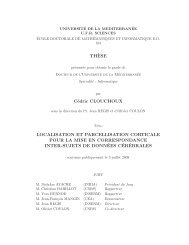Introduction au recalage - Olivier Coulon
Introduction au recalage - Olivier Coulon
Introduction au recalage - Olivier Coulon
You also want an ePaper? Increase the reach of your titles
YUMPU automatically turns print PDFs into web optimized ePapers that Google loves.
Optimisation L’approche est dans la plupart des cas itérative : on améliore pas à pas latransformation estimée jusqu’à convergence. Attention <strong>au</strong>x mimima loc<strong>au</strong>x. Il f<strong>au</strong>t très souvent estimer une transformationinitiale, suffisamment proche de la solution (dans le « capture range ») pourinitialiser l’algorithme. Pour cela une stratégie multi-résolution est parfois utilisée. On recale à très basserésolution, le résultat sert d’initialisation pour un <strong>recalage</strong> à meilleure résolution,etc… Dans le cas d’un <strong>recalage</strong> non-rigide, on peut hiérarchiser les transformations :d’abord une transformation rigide, puis affine, puis déformations locales. IMPORTANT : souvent, on ne cherche pas le minimum global mais le minimumlocal le plus adapté.Master MINT – Analyse d’images<strong>Olivier</strong> <strong>Coulon</strong>5 . <strong>Introduction</strong> <strong>au</strong> <strong>recalage</strong>



